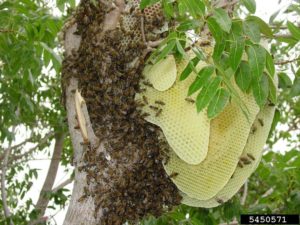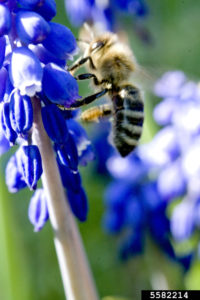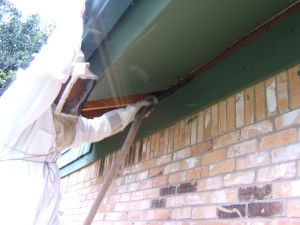General Information

Wild (feral) honey bee (apis mellifera) colony in a tree.
Honey bees are social insects, living in colonies containing (during summer when the population is high) 60 to 120 thousand individual workers, a few hundred drones and a queen. Like most bees and wasps they will defend their nests when disturbed. Honey bees can only sting once because their barbed stinger remains in the individual or animal when stung, causing the last abdominal segments of the honey bee to be ripped off. This results in the death of the honey bee. When disturbed, a few hundred bees will emerge from the nest and attack the intruders. In contrast, Africanized honey bees are often much more defensive.
Honey bees are the primary pollinators of 2/3 of the food we eat, either directly or indirectly. They gather nectar from flowers to make honey and collect pollen from flowers during pollination and use them for food. When there are few nectar sources blooming, honey bees will forage in any source that has sugar, from trash cans to soft drink cans, to sweets like candy and fruits. Man cares for and manages honey bee colonies in hives and extracts the excess honey and pollen that the honey bees produce. The colors of honey are produced by the floral sources from which the honey bees gather the nectar from. Wax, propolis (resinous bee glue), honey bees and queens are other products that beekeepers harvest from the hives they manage. Unlike other bees and wasps, a reduced colony will overwinter, rather than just the queens.
The Africanize honey bee is currently only found in Southeastern and Southwestern states. The Africanized, like the European honey bees, can only sting once since the barbed stinger remains in the human or animal, ripping off the last segment, causing the death of the honey bee. The amount of venom received in a single sting is about the same for Africanized and European honey bees. Serious injury or fatality comes from the significantly greater number of Africanized honey bees that sting compared with European honey bees. Africanized honey bees are known to take over European colonies. They are noted for the process of absconding, where the entire colony picks up and leaves a location due to lack of a food source or disturbances. This can happen several times a year and, in conjunction with swarming, is what accounts for their rapid spread and movement of 200 to 300 miles a year.
Identification

Western Honey Bee, Apis mellifera on Grape Hyacinth
Honey bees Apis mellifera mellifera are about ½ inch in length with an orange to yellowish-brown color and black intersegmental bands on the abdomen. The legs, antenna and eyes are black and the thorax, abdomen and legs are densely covered with hairs. They build their nest of wax and nests may be located inside of structures (walls) or trees or hanging from protected locations on trees or other structures. Whether in walls or exposed, the nest is a series of double sided wax sheets that are arranged in patterns.
The Africanized honey bee Apis mellifera scutellate is a hybrid cross between an African subspecies and the European subspecies. The Africanized honey bee is slightly smaller than the European honey bee but cannot be distinguished just by looking. Color patterns, markings and body characters are the same, making it impossible to separate them by visual observation. They build the same type of wax nest and may be located in walls, structures, trees or hanging from trees or structures. But, unlike their European cousins they will nest in unusual places like the ground, water meters and even barbecues.
Suggested Thresholds
- One teacher/staff complaint(s) received, or 5 or more honey bees observed near food or picnic tables.
- Observance of bees coming and going from an opening in a tree or school structure, or report of honey bees in a classroom.
Bees, wasps, hornets, and yellow jackets are among the insects that can sting humans and other animals. Management of these insects should not be attempted by inexperienced or ill-equipped individuals. Honey bee removal from structures is not a job for a person who has never worked around stinging insects or even a novice beekeeper. Removing honey bee nests from cavities (walls of houses, hollow trees) is a time-consuming, labor-intensive practice usually done by professionals. If you have any concerns, contact a pest management professional to do the job for you. Yet, these insects are among the most beneficial organisms economically, with bees providing pollination services worth an estimated $3 billion annually in the US.
Monitoring and Inspection
Stinging insect nests can be located in a variety of places including in the ground, in masonry or other wall voids, on the eaves of buildings, on fences or in trees. In environments where these species occur frequently, a monthly inspection of buildings and grounds for nests during the active season may be warranted, with more frequent inspections during nesting seasons for problem species. Generally, new nests are established in the spring or early summer. This is true for both wasps and honey bees.
Honey bees become defensive when people and animals approach colonies with brood present. In regions where Africanized honey bees are present, specific instructions should be provided for avoiding and responding to attacks. These include a set of guidelines on what to do if bumped or stung by a bee. For example, guidance can include if you find yourself bumped by a bee, stop and cover your head with clothing or at least cover your nose and mouth with your hands, look through your fingers or clothing to see if you can determine where the colony is and move in the opposite direction; if you are stung by a bee carefully run away in a straight line at least the length of a football field, seek shelter in a building or vehicle, and avoid other people unless they are offering you aid.
Swarms of bees occur when a new queen is in transition and searching for a new nest with her colony. Swarms are most common in the spring or early summer. In most cases this swarm is harmless. In most cases you can wait 24 hours to see if the swarm moves on and keep children away from the site. Otherwise, seek removal by qualified individual or company. Make a list of available beekeepers for assistance, with names and phone numbers. In certain locations, regulations specify that feral nests or swarms must be assumed to be Africanized and destroyed rather than collected by a beekeeper. Region-specific advice is usually available from local Extension specialists or the Department of Agriculture.
Nonchemical Control Measures
Anyone taking action against a stinging insect nest or managing traps should take precautions to avoid being stung, including wearing protective gear when appropriate, and remediating colonies at the appropriate time of day. Stinging insect nests that are located in areas where they are unlikely to be disturbed are best left alone. When persistent problems occur, proper identification of the species is essential due to the wide variety of food sources, nesting sites and behaviors of this large group. A good understanding of these characteristics is key to finding effective, long-term solutions.
Education is an important element of stinging insect management. Staff and students should be instructed to report stinging insect nests on school grounds, to avoid wearing strong perfumes or eating or drinking outdoors during problem times of year, and to avoid panic when encountering stinging insects or nests. Many more injuries and deaths from encounters with bees result from panic reactions including running into traffic, etc. than from an insect sting.
Sanitation/Cultural Control Measures
- Remove individuals with a vacuum or flyswatter.
- Eliminate harborage by sealing openings in exterior surfaces including walls, masonry steps, bleachers, fences, playground equipment, etc.
- Clean up food and drink spills immediately.
- Store food items to be consumed outdoors in sealed containers.
- Do not plant flowering trees, shrubs or flowers immediately adjacent to building entrances or walkways.
Physical/Mechanical Control Measures
- Use strong liners for waste containers that do not rip and create spills in dumpsters and trash cans.
- Empty outdoor trash cans frequently to prevent overflow, and ideally in early afternoon and again at dusk.
- Use outdoor waste containers with spring-loaded doors and keep dumpster lids closed.
- Place outdoor trash cans and dumpsters away from building entrances.
- Fix plumbing leaks, gutters that hold water, etc. to eliminate access to water.
- Nest Removal

Removing bees from the side of the building before removing the hive.
- A nest can be destroyed through physical removal (vacuuming) or by using a pesticide (see Chemical Controls). Either way, great care must be exercised because any disturbance around a nest can cause multiple stings. It is best to have a professional pest control operator (PCO) or other experienced person remove the nest. Nest removal should take place at night when the children are out of school and the yellowjackets are inside the nest. When illumination is needed, use a flashlight covered with red acetate film so it will not disturb the wasps. Adequate protective clothing and proper procedure can minimize problems and stings. It is important to wear protective clothing when removing wasp nests. Complete body coverage is essential because yellowjackets and other wasps can find even the smallest exposed area. Use clothing made for beekeepers. This includes:
- A bee veil or hood that either contains its own hat or can be fitted over a light-weight pith helmet or other brimmed hat that holds the veil away from the head. A metal-screen face plate that extends around the head is a desirable feature. Check the veil carefully for tears before each use.
- A bee suit or loose-fitting, heavy-fabric coverall with long sleeves. This is worn over regular pants and a long-sleeved shirt to provide extra protection from stings.
- Sturdy high-topped boots with pant legs secured over the boots with duct tape to prevent wasps from getting into trousers.
- Gloves with extra-long arm coverings so sleeves can be taped over them to protect the wrists.
- A more detailed description of the nest removal process is provided at these links, “Honey Bee Colony Removal From Structures”.
- A nest can be destroyed through physical removal (vacuuming) or by using a pesticide (see Chemical Controls). Either way, great care must be exercised because any disturbance around a nest can cause multiple stings. It is best to have a professional pest control operator (PCO) or other experienced person remove the nest. Nest removal should take place at night when the children are out of school and the yellowjackets are inside the nest. When illumination is needed, use a flashlight covered with red acetate film so it will not disturb the wasps. Adequate protective clothing and proper procedure can minimize problems and stings. It is important to wear protective clothing when removing wasp nests. Complete body coverage is essential because yellowjackets and other wasps can find even the smallest exposed area. Use clothing made for beekeepers. This includes:
Chemical Control Measures
A number of low toxicity, effective pesticide options are available for stinging insects, including formulations that can be used in a way that minimizes exposure to non-target organisms. A commercially available wasp and hornet spray for killing the bees and wasps can provide quick knockdown and can be used from a distance, but provides no residual control. Dust formulations of labelled pesticides, including boric acid dusts, may also be pumped onto an enclosed nest. Application of liquid residual pyrethroid sprays can be made to known harborage areas, but it is difficult to get liquids sprays to all of the nest. There is evidence that soapy water is also a very good material (use one cup of liquid soap per gallon of water sprayed or a soapy foam). This is inexpensive and relatively environmentally benign. How the bees are killed will depend on the particular situation.
Always read and follow the label. The label is the law. Pesticides must be used in accordance with federal, state and local regulations. Applicators must have proper credentialing to apply pesticides and should always wear personal protective equipment (PPE) as required by the pesticide label during applications. All labels and Safety Data Sheets (SDS) for the pesticide products authorized for use in the IPM program should be maintained on file.
Evaluation Methods
For swarming bees – watch for 24 hours, if swarm is still there after 24 hours watch swarm to see if they have established a next close by.
For hive removal ensure that entire colony has been killed or removed, the comb has been removed and cleaned and disinfected.
Compiled from publications by Dale Pollet, PMSP, S. Darr, T. Drlik, H. Olkowski and W. Olkowski, O’Malley et al.
